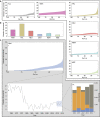Full circumpolar migration ensures evolutionary unity in the Emperor penguin
- PMID: 27296726
- PMCID: PMC4911614
- DOI: 10.1038/ncomms11842
Full circumpolar migration ensures evolutionary unity in the Emperor penguin
Abstract
Defining reliable demographic models is essential to understand the threats of ongoing environmental change. Yet, in the most remote and threatened areas, models are often based on the survey of a single population, assuming stationarity and independence in population responses. This is the case for the Emperor penguin Aptenodytes forsteri, a flagship Antarctic species that may be at high risk continent-wide before 2100. Here, using genome-wide data from the whole Antarctic continent, we reveal that this top-predator is organized as one single global population with a shared demography since the late Quaternary. We refute the view of the local population as a relevant demographic unit, and highlight that (i) robust extinction risk estimations are only possible by including dispersal rates and (ii) colony-scaled population size is rather indicative of local stochastic events, whereas the species' response to global environmental change is likely to follow a shared evolutionary trajectory.
Figures


References
-
- Hoffmann A. A. & Sgrò C. M. Climate change and evolutionary adaptation. Nature 470, 479–485 (2011). - PubMed
-
- Thomas C. D. et al. Extinction risk from climate change. Nature 427, 145–148 (2004). - PubMed
-
- Chown S. L. et al. The changing form of Antarctic biodiversity. Nature 522, 431–438 (2015). - PubMed
-
- Saether B. E. et al. Generation time and temporal scaling of bird population dynamics. Nature 436, 99–102 (2005). - PubMed
Publication types
MeSH terms
Associated data
LinkOut - more resources
Full Text Sources
Other Literature Sources

